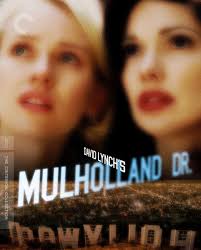It has taken me a long time to realized that my endless fascination with David Lynch’s Mulholland Dr. is in part because the dream-logic, nightmare-adjacent film is a fusion of two of my favorite film genres, Noir and Horror.
Mulholland Dr is a twisted terrifying tale of Hollywood, the emptiness of its illusions, the  corrosive nature of obsessive dreaming, and the ultimate destruction of self and identity when we allow our dreams to become more vital than our reality.
corrosive nature of obsessive dreaming, and the ultimate destruction of self and identity when we allow our dreams to become more vital than our reality.
Naomi Watts stars as Betty a fresh-faced aspiring actress recently come to Hollywood after winning a dancing contest and as Diane, a bitter broken woman whose dreams of stardom and love have been crushed by the heartless engine that is Los Angeles. Laura Harring plays Rita, a mysterious amnestic woman who has barely survived an attempt on her life that stumbles into Betty’s life and Camilla, as fellow actor that has all the success Diane never achieved and who has spurned Diane for other lovers leaving Diane bitter and murderous.
If that sounds confusing it is but that is often the deep style of a David Lynch film. Lynch doesn’t photograph reality but rather his films follow the logic of a dreamer on the cusp of waking and often it can be difficult or even impossible to separate what is real from what is dream and what is symbolic. Lynch rarely will have explanations within his narrative and outside of the piece never explains his work. It is your viewing and your emotional reaction and your interpretation that matters as to a film’s meaning. The film is incomplete without your participation in the dialog between artist and audience and Lynch will not corrupt the process by instructing you on your side of that conversation.
The most common description of the events of Mulholland Dr., and one I agree with, is that Betty is the escapist dream of failed Diane’s life, and that in the Club Silencio scene the dream crumbles revealing disastrous reality that collapses into hallucinatory psychosis.
This film is a niche taste and not for those expecting a direct, linear narrative where what you see on the screen reflects a fictionalized reality.
